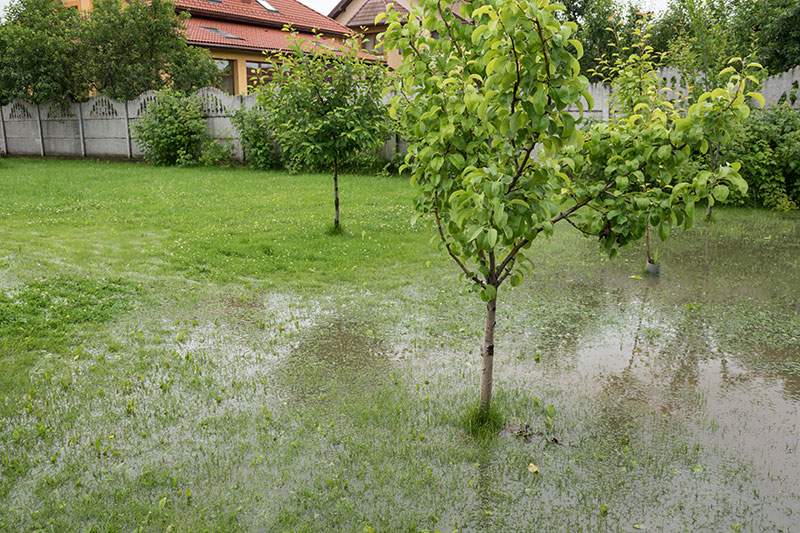Overview
There are often some seasons in which the norm is weather that is far much too wet than on normal occasions. Many people are often excited about the change of weather and often embrace it. This is because continuous rainfall may work to give one a break from the tending work that is often necessitated in the yard. However, over time, it may force you to tend to the lawn, especially during and after the long rainy seasons. This is mostly because prolonged rains may end up irrigating your lawn, and you may therefore have to deal with taking care of it. There are a couple of things that you may have to deal with, such as soil erosion, fire ants, fungus and even grass that becomes funky-colored over time. However, there are different things that can be done, in a bid to prevent the lawn from getting waterlogged. Also, there are quite a number of solutions that will work best in getting back into a more appealing green state.
Measures to take to Prevent Lawns from getting Waterlogged
In as much as there is not much that can be done to control rains, there are several measures that can be put in place, to prevent the lawns from getting waterlogged. There are things that you can do, in a bid to take better care of the lawns. Below are some of the important measures that can be done in a bid to prevent the lawns from getting waterlogged.
a)Improvement of soil drainage
Soil that is well-drained often allows for water to drain easily in to lawns, such that the the lawns do not become bogged. This should be done in such a way that there is enough water that is able to get all the way to the roots for absorption. In the event that the soil in your lawn is very heavy, then you can use the aeration procedure, in a bid to loosen it up a bit. Alternatively, you can improve its structure by spreading a layer of about half an inch or even less; on top of the grass on your lawn. What will happen is that it will act as a sponge and allow for water to trickle down slowly.
b)Use of gutters
You need to make sure that your gutters are constantly cleaned, so that they do not inhibit allowing water to be directed to where necessary. You must ensure that these channels are well-functional at all times. You can do this by ensuring that there is nothing in their pathway that may result into the gutter being clogged. Additionally, ensure that your trees are well maintained, so that more sunlight can reach the lawns, thus allowing them to dry out faster.
c) Maintaining resilience of the lawns
It is very important to ensure that the lawn is well taken care of, so that it can become more resilient. Generally speaking, lawns will tend to survive for prolonged periods of time, if at all they are submerged in water completely, with roots that are strong enough. It is therefore advisable to take better care of them by ensuring that they are rightfully watered, mowed and fed at the right times.
Ways by which Wet Grass can be Saved
If at all the grass on your lawn is too wet, there are some problems that can be associated with the latter. Below are some of the problems that are associated with wet grass and how best to fix them:
i)Discoloration
This problem is often brought about by the soil getting so much saturated with water, such that oxygen does not get to reach the soil sufficiently. Because of this, the roots often do not get enough nutrients and water, hence resulting to the grass turning either yellow or brown. The solution to this problem is waiting for the lawn to dry up and then treating it with lawn food with insect control. The latter will help in getting the lawn strengthened.
ii)Soil erosion
Strong storms, coupled up with extensive rainfall overtime may often end up leading to soil erosion. This is often experienced especially on lawns that are sloping. The problem of soil erosion may not be so badly off if at all the lawn is well established and thick. However, for lawns that have become patchy due to soil erosion, you may need to reseed for a fresh start. Also, you may consider re-fertilizing, since the fertilizers that had been initially used may have been washed away.
iii)Moss development
Lawns that have been soaked in water may often end up gathering moss. These may often end up being filled with thin spots and may end up making the lawn look less appealing. You can take care of this problem by raking it up and having it disposed. However, this may only work for the short term. In order to prevent it from growing back, you can use anti-moss chemicals, that will inhibit the moss from growing back.
iv)Fungal problems
Wet grass is often a breeding ground for all types of fungal diseases. Some of these may include powdery mildew, southern blight and yellow patch. You should be on the look out for any signs of this, such as irregular patches on the grass, dead rings and grass that has gets discolored. This can however be treated by using anti-fungal fungicides.
v)Fire ants
These are some of the other main occurrences of lawns that are waterlogged. They often appear on the surface of the lawns after long rains, because they are often moving to the top, to avoid drowning. These ants may become a nuisance, and should be controlled by spraying the relevant insecticides, that will help get rid of them completely.
How to Mow Wet Grass
Carrying out regular mowing on your lawn is very important. In as much as you can have the lawns mowed during the rainy season, there is a specialized way of doing it. This is described below:
a)Ensure that you wait until it is less wet
You need to wait up until it is less soggy, to do the mowing. Do not do it when there are still pools of water around.
b) Mow by pushing and not riding
Ensure that you go for a push mower. This is because the riding mowers for lawns are often very heavy, and can therefore cause soil erosion.
c) Ensure blades are well-sharpened
You must ensure that the blades that you are using for mowing are super sharp, so that they are able to easily break clumps of the wet grass on the lawn.
d) Leave the clippings
While mowing, you need to make sure that you leave the bags skipped and also leave the grass clippings to dry on the lawn. This is to be done, in a bid to ensure that you rake out all the clumps that may suffocate the grass underneath.
e) Avoid mowing low
Because of the rains, the grass on your lawn may have grown quite tall. You therefore need to make sure that you are only cutting a third of the grass, at any given time. Do not cut the grass to the roots.

